Introduction
To ask me to discuss Howard’s contributions to marketing is like asking a child on Christmas Day whether he believes in Santa Claus! The socialization process, the heavy commercialization of the concept of Santa Claus as well as continuous reinforcement awarded the child in believing in Santa Claus, all conspire to make the child less deliberate or objective and more affectively dependent on that belief. Not that there is anything wrong in believing in Santa Claus. After all, the child usually outgrows his beliefs and reexamines the same concept from a somewhat different and independent perspective. Given, a’ association with John Howard as his student, his coauthor and his colleague, I would be less than candid if I didn’t admit feeling like that child. Hopefully, I have matured enough to outgrow emotional faith in Howard’s or and to be in a posit ion to evaluate it more objectively. At least, let me try.
A Perceptual Mapping Of Howard’s Contributions
In order to fully comprehend and integrate many different types of contributions Howard has made to the discipline of marketing over a period of more than two decades, I have seach2d for the number end kinds of underlying dimensions on which his contributions have varied. The result is a totally nonanalytical but probably highly descriptive map a la multidimensional scaling tradition represented in Figure 1. Similar to most multidimensional scaling examples and applications, Howard’s contributions to marketing are at least two—dimensional in nature. The first dimension represents a continuum ranging from managerial to public policy related research contributions. The second dimension represents another continuum ranging from theoretical to empirical aspects of his research contributions.
Chronologically, Howard’s contributions began on the managerial side of the two—dimensional space with the publication of the first edition of Marketing Management (1957). Even though it was only a textbook it had the theoretical richness unparalleled among other books on marketing at that time. Howard may probably the first scholar in marketing to systematically provide a managerial orientation to the marketing thought very similar to what Joel Dean did in economics.
Soon thereafter Howard shifted his attention to the area of consumer behavior and concentrated on less economic and more psychological foundations underlying consumer’s brand choice behavior. This new area of research resulted in a monumental series of publications starting with Marketing: Executive and Buyer Behavior in 1963 and culminating in The Theory of Buyer Behavior in 1969. As one historically reviews various publication during this period, he ii struck with two observations: the maturity of thought is almost evolutionary and the divorce from managerial perspective is almost total so that the latest publication on buyer behavior theory begins to emerge more as an understanding of buyer behavior from the point of view of the consumer rather than that of the marketer.
This shift in perspective may be more responsible in making buyer behavior theory almost look like a theory of human choice behavior generally found in psychology. It would appear that this shift from managerial marketing may be in part responsible for comments, criticisms and even questioning the relevance of buyer behavior theory in marketing (Maloney, 1973; Webster, 1970; Runt and Pappas, 1972). Taking all things Into account, it would appear that these were Howard’s most formative years in terms of genera ting a body of knowledge at a rigorous and scientific level. It is, therefore, probably no exaggeration to state that the genesis of modern marketing thought exemplified.] in the concept of customer—oriented marketing planning and strategy owes a great deal to his pioneering efforts In generating a respectable body of knowledge which made consumer look more deliberative and rational, and less as defenseless, manipulatable entities in the market place. A second, and more subtle, contribution was the demonstration of dramatic similarities between the institutional and household consumers which led to calling the research on customers as buyer behavior instead of consumer behavior.
A third shift In Howard’s research activities would seem to be in the direction of empirical research on buyer behavior. Empirical research at first took the form of relatively small scale in-depth studies of the decision making process among the organizational managers and buyers (1965, 1968). This research was very heavily Influenced by the Simon tradition of bounded rationality and the information—processing approach to studying decision processes. It is somewhat surprising to note that very few recent studies on information processing a la decision nets (Bettman, 1974) even refer to Howard’s pioneering research almost a decade before anyone else in marketing.
A second phase of the empirical research involved a large scale and continuous research to test the Howard—Sheth theory of buyer behavior under what is commonly referred to as Colombia Buyer Behavior Project. Under Howard’s leadership more than a dozen scholars and doctoral students operationalized and tested various elements of the Howard—Sheth theory. In its scope and procedures, Columbia Buyer Behavior Project also has remained unparalleled at least in the academic setting. Finally, Howard’s interest in empirical research also led him to work toward the organization of, and mission for such fundamental research institutes in marketing as Consumer Research Institute and Marketing Science Institute.
Just about when empirical research was getting published, a fourth shift occurred in Howard’s interests in the direction of public policy issues of marketing. These were more clearly manifested in providing to policy makers the theoretical underpinnings of consumer decision processes, and in providing them with guidelines with which to evaluate the impact of advertising claims including deceptive and exaggerated claims (Howard and Hulbert, 1974). While it is too early to assess the impact of his thinking in the public policy area, it has not been immune from comments and criticism in the academic circles (Sachs, 1975).
The most recent shift is toward conducting empirical research on societal problems such as nutrition and population. This is manifested by way of a new research institute at Columbia University. This shift from theory to empirical research in the public policy area roughly parallels a comparable shift almost a decade ago he made in the area of buyer behavior. If history could be trusted as a good extrapolator into the future, Howard should be ready to generate yet another theory in some future contemporary issue in marketing. Let us see whether the prophecy is fulfilled.
Another look at Figure 1 which summarizes Howard’s major contributions to marketing reveals several fascinating aspects to his research thinking which may be loosely called his “style of research”. First, Howard seems to concentrate on those areas of marketing which are out of the ordinary at that time and eventually become the mainstream of marketing thought. Examples are the managerial and the customer— oriented approach to marketing theory, Second, without a doubt Howard seems to have acted as a catalyst or change agent in marketing innovations. Third, Howard appears to be a Texan at heart. Most of his endeavors have been big whether they are in building theories or in conducting research. Finally, Howard seems to have the knack to gene rate controversy, criticism and additional effort on the part of others to revise or modify his thinking. The classic example is the impetus for further research and concomitant controversy generated by the Howard—Sheth theory of buyer behavior (Hunt and Pappas, 1972; Ward and Robertson, 1976; Maloney, 1973; Webster, 1970).
Enough on generalities and praise on Howard’s contributions to marketing. It is about time to focus on the contribution he has made namely the development and emergence of a comprehensive theory of buyer behavior. For no other reason than that I just finished teaching a doctoral seminar with it, I will utilize the Howard—Sheth theory of buyer behavior for a critical review and analysis. Let me state at the outset that among many disadvantages of coauthor ship, there is at least one advantage: you can blame the weaknesses on the other guy.
There is no question that the Howard—Sheth theory of buyer behavior is widely, if not universally, accepted by the academic community as witnessed by frequent references to it in the literature. It is also more and more applied and adapted by marketing research departments In the industry as a means of providing a comprehensive perspective and vocabulary to collect micro level data on customers. Finally, it is gaining entry and acceptance among public policy makers and researchers as evidenced by Howard’s utilization of the theory to guide the Federal Trade Commission.
However, a better test of how good the theory is rests on its successfully passing a number of metatheory criteria such as internal consistency, linguistic exactness, empirical interpretability, methodological simplicity, originaj.tty, external consistency, stability and the like (Zaltman, Pinson and Angelmar, 1973). Since such an evaluation has been already performed by those who have not been associated with the theory, it is beet to reproduce their evaluation in Table 1. According to Zaltman, Pinson and Angelmar (1973), the Howard—Sheth theory of buyer behavior out performs or at least matches other theories in consumer behavior on several criteria chosen by them to perform a stringent evaluation task.
While the Howard—Sheth theory is generally accepted as good, it is by no means perfect. There are a number of areas of potential improvement and future extensions of the theory largely because either the theory is not fully specified or it has done insufficient justice to several of its parts. I will try to isolate several aspects of the theory which need further research and even rethinking before the theory is accepted as a final word in consumer behavior. Parenthetically of course, the reader will understand the psychology of self—criticism and self—refutation: it is at least one way to keep myself alive and kicking despite coauthoring and writing comprehensive theories!
Perhaps the single most important weakness of the Howard—Sheth theory is the decision—making and problem—solving approach it has taken in explaining consumer brand choice behavior. Such an approach unfortunately forces the authors to treat all consumer choices as highly deliberative, cognitive and even rational decision—making processes minimizing the possibility of being manipulated by the marketing activities. As Sheth and Raju (1975) have pointed out, systematic brand choice behavior can arise by at least four distinct processes (situational influences, novelty, curiosity, emotive or other nonspecific motivational processes, habit and decision—making process) only one of which is the highly deliberative cognitive process. While the Howard—Sheth theory does discuss novelty—curiosity as well as routinized response behavior, the emphasis is much less on these nondeliberative processes. In a way, it is unfortunate that too soon too many social sciences have adopted the Simon’s problem—solving and decision— making approach as the only viable process underlying systematic choice behavior without properly observing the realities of human choice.
Second, even in the decision—making approach underlying the Howard— Sheth theory, it is limited to individual brand choice behavior. This explicitly excludes a vast number of decisions both in the family and in organizations. The theory is to that extent not comprehensive enough to encompass all types of brand choices actually occurring in the market place. Perhaps the recent efforts in extending the theory to accommodate both autonomous and joint decisions (Sheth, 1973; Sheth, 1974) may make the theory more realistic.
Third, it is only a theory of brand choice behavior and not all aspects of buyer behavior. By focusing on the processes of brand choice decisions and how marketing communications (significative and symbolic) affects them, the theory has either ignored, or at best given only a cursory treatment to the highly Integrated and interdependent flow of activities associated in buyer behavior including the linkages between brand choice and store choice decisions. While there is a flow chart analysis of motor and mental steps evoked by a consumer in a highly routinized situation in the Howard—Sheth theory (Chapter 5), it is not given the same prime importance as prediction of brand choice behavior from attitudes and intentions. It is my opinion that we need to more fully understand the sequence of behavioral activities involved in buyer behavior either by qualitative research or by time and motion study of consumer behavior. It is only such type of research which will bring to the forefront the importance of situational variables as well as behavioral antecedents which generate a need to choose among alternatives.
Fourth, the theory has created a major structural weakness by mixing together static and dynamic constructs. I am referring to the inherent difference between the learning constructs and the perceptual constructs. In my numerous attempts to adapt the theory for industry research, it has proven virtually impossible to create a single research design which cam satisfactorily track both learning and perceptual constructs. It would appear that it is relatively easy to measure the learning constructs (attitudes, intention, satisfaction, choice criteria) by way of a cross—sectional survey. Howe ever, it almost invariably requires either an experimentation or laboratory observation to measure perceptual constructs (attention, perceptual bias, overt search, ambiguity).
Fifth, as Howard and Sheth themselves point out, there are at least two areas in the theory which are relatively weak and need further thinking. The first is the process of search. What initiates search behavior on the part of the individual? How does he go about searching for alternatives and information? Is there a cognitive limit inherent in the search process even if it is carried out on a temporal basis? What about the question of optimum information and the problem of information overload suggested by Jacoby (1974)? Finally, are there individual and situation differences in the search behavior of people? A theory of search behavior is badly needed especially in light of the contemporary concerns about the overload of both quality and quantity of information communicated to the people.
A second area which needs further thinking and theorizing ie the process by which the individual codes the stimulus display. The question of stimulus—as—coded is highly relevant and useful even from the marketing and advertising viewpoint. In fact, I have elsewhere suggested that the standard measures of advertising effectiveness such as recall, recognition, readership, as well as the more cognitive instruments such as Reaction Profile or Schwerinks Preference Shares are simply measures of how the stimulus got coded in the mind of the individual and not measures of impact of advertising on consumer behavior (Sheth, 1973). Furthermore, even in the utilization of standard instruments in advertising, no one as yet know the model by which an advertising communication i.e processed by the individual:
it still remains a black box. While the Howard—Sheth theory probably went farther than most theories in providing tentative and as yet speculative ideas in terms of quantity (attention) and quality (perceptual bias) of information distortion, it is not enough to be directly applicable to either managerial or public policy planning purposes. This is not so much a criticism of the theory per as it is a reflection on the potential areas of further research in consumer behavior.
Sixth, the empirical testing of the theory has made it obvious that considerable more imagination and effort are needed to operationalize the various hypothetical constructs with the judicious use of psychometric scaling procedures. In today’s fervor to quantify anything and everything to gain respectability, as well as the strong biases of all the scholarly marketing journals toward empirical research, it is even doubly necessary that the researcher not only present a theory which can stand the tests of logic and face validity but also at the same time provide exact operational rules of correspondence for various constructs in his theory. Otherwise, the empiric al tests such as those by Parley and Ring (1974), no matter how imaginative they may be, are bound to generate criticism, and even more sadly, a premature discarding of an otherwise very rich theory. Unfortunately, but rightly, the burden of providing psychometrically scaled and standardized instruments for the hypothetical constructs of the theory must fall on the authors of the theory. In fact, there is ample evidence in attitude literature that extremely good and rich theories go by the wayside and remain unnoticed simply because the author failed to take one additional step in terms of operatioealizing his theory. And at the same time, some relatively weak theories are adopted very rapidly, and often blindly, simply because the author took pains to operationalize his constructs. This contrast is very vivid between Katz’s functional theory and Fishbein’s cognitive theory in attitudes.
A related problem to operationalization of the theory constructs Is the need for a priori homogeneous segments of consumers to avoid the problems of statistical artifacts due to aggregation. While the Howard—Sheth theory has admirably theorized the problem of heterogeneity of respondents by way of exogenous variables, there are very few empirical tests of the model which have a priori segmented the market and then to treat the theory on individual homogeneous segments.
In order for the Howard—Sheth theory or any other theory to gain greater acceptance in marketing and enhance the respectability of marketing as a discipline among social Sciences, it ii very critical that in the next decade we concentrate more on scaling and validation of constructs and less on developing new theories (Sheth, 1974). This is especially crucial for comprehensive or grand theories in marketing given the present winds which favor middle range theories.
Finally, it seems that the time is ripe to also attempt theorizing about consumer behavior in a general sense and not from the perspective of marketing management, public policy, consumers or academic research. All the existing theories in consumer behavior have a managerial app roach built into them. Perhaps Howard has gone farther than most in adapting the theory for public policy purposes. Still they are all developed on the presumption that the theory and related research are simply essential inputs to someone else’s planning and strategy decisions. This has often led to semantic and Scaling problems in the sense that the definitions and measurements of constructs are highly oriented toward the managerial or public policy perspectives. For example, breed choice, brand loyalty and intention to buy are all variables or constructs defined and measured in a way to be relevant for those industries which have monopolistic competition structure. This often limits the scope of the theory and makes the process of adaptation or generalization difficult to other industries with a different competitive structure such a. a monopoly. It would appear that just as the words like product, price, promotion and distribution have hindered the acceptance of marketing as a reallocation process for nontraditional products and services such as contraceptives, education and welfare, the same thing is also happening at present in consumer behavior even in term of extending the theory to the other traditional areas such as organizational buyer behavior. In short, we need to build a theory of buyer behavior and the concomitant scaling of its constructs which is free of any outside perspective. At this will speed up the divorce between buyer behavior and marketing coi5parabje to the divorce between marketing and economics which took place in the twenties with product differentiation and distribution delegation. If for no other reason, I love to watch the processes of divorce!
References
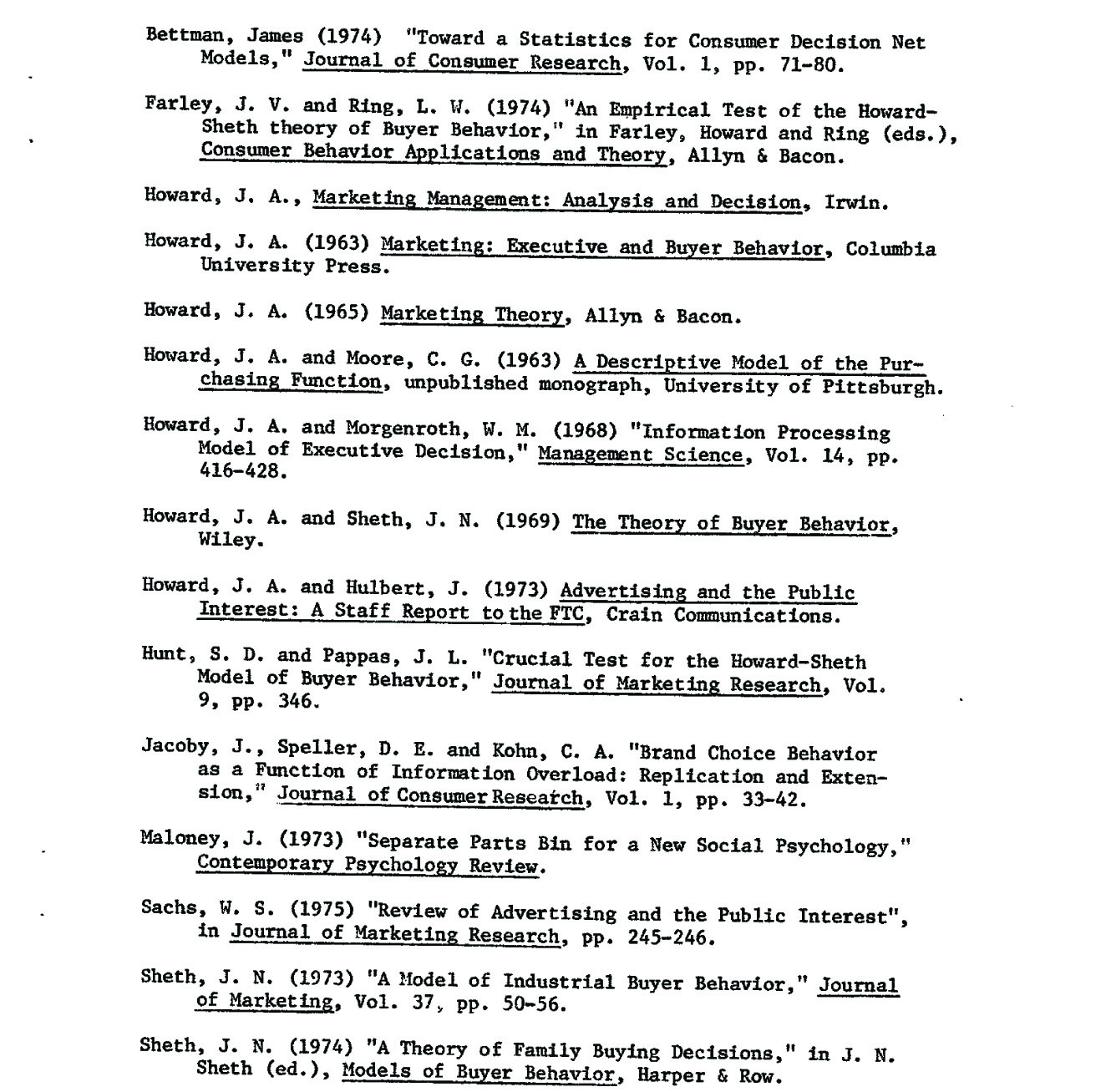
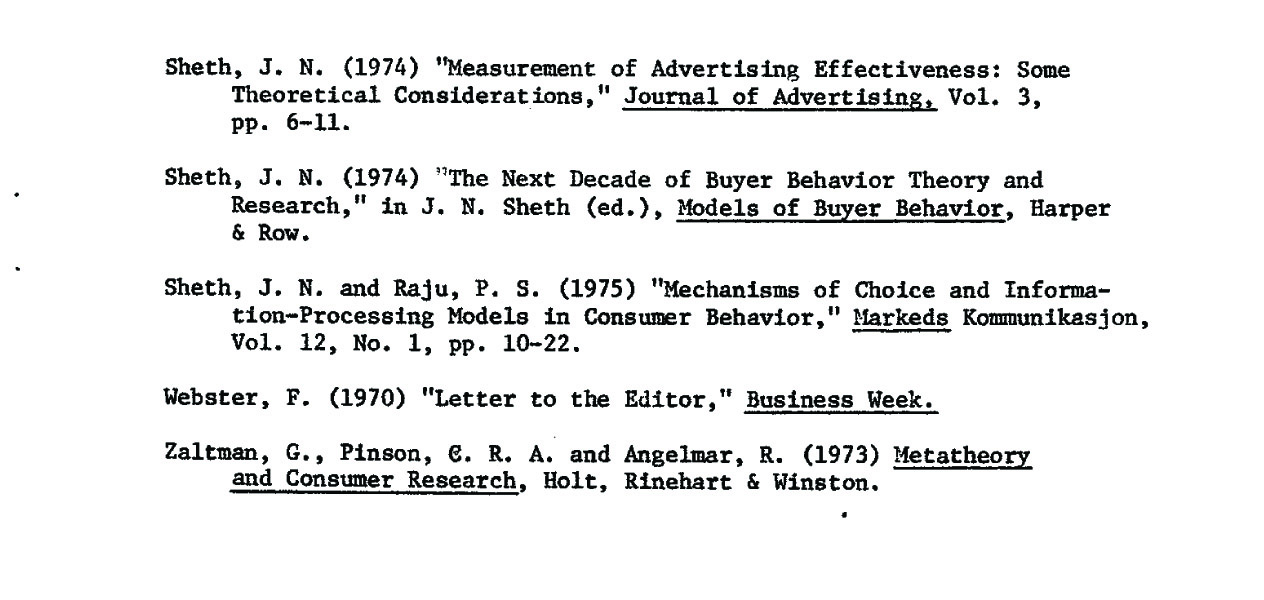


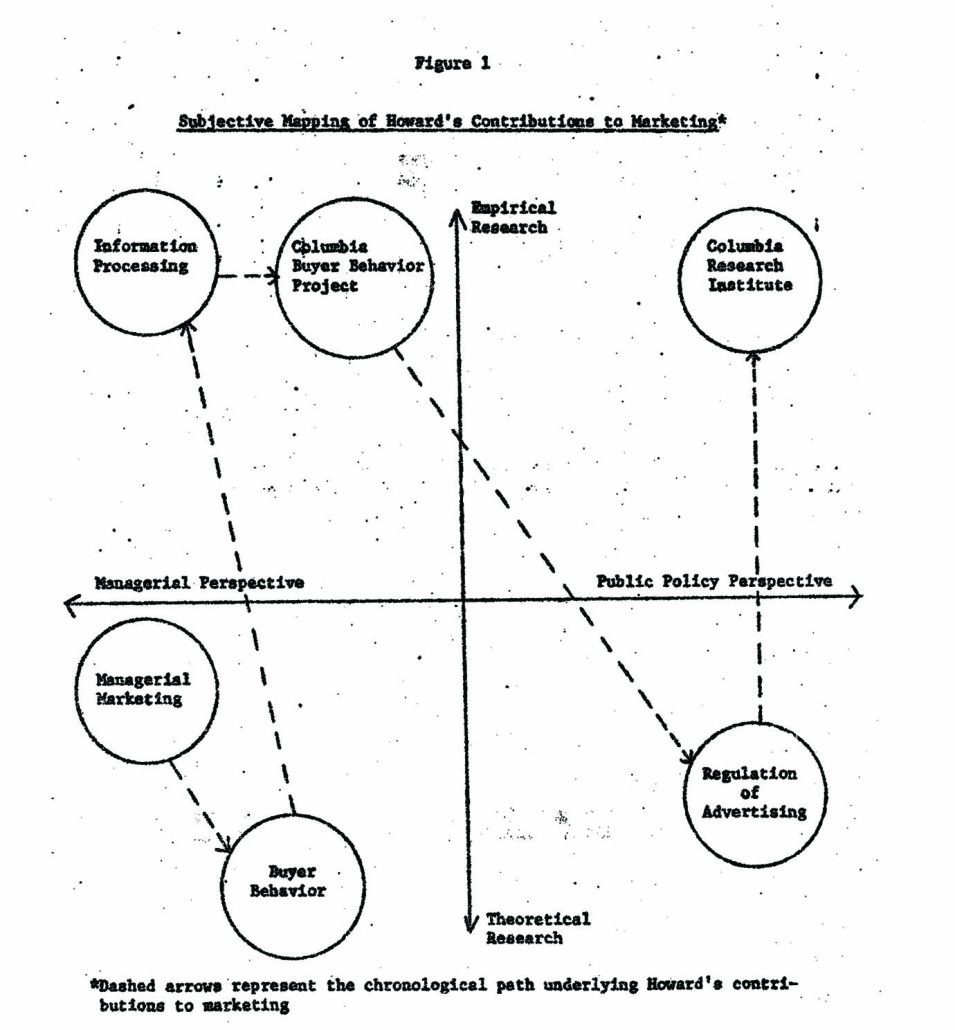
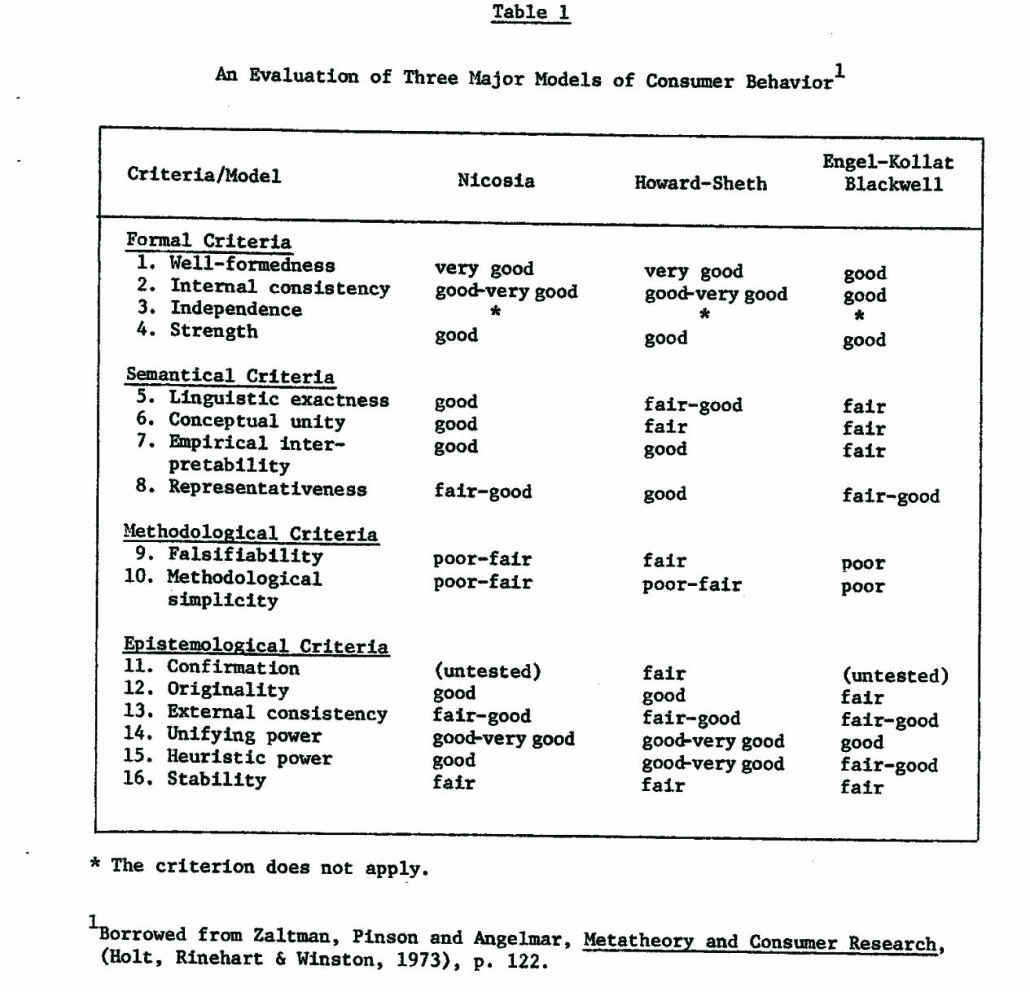


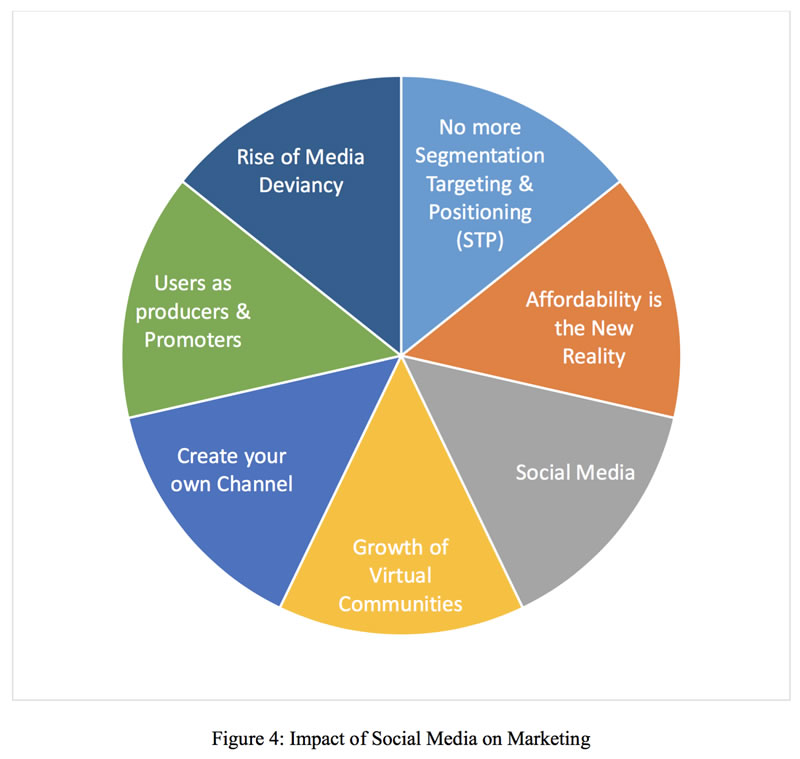
One Comment